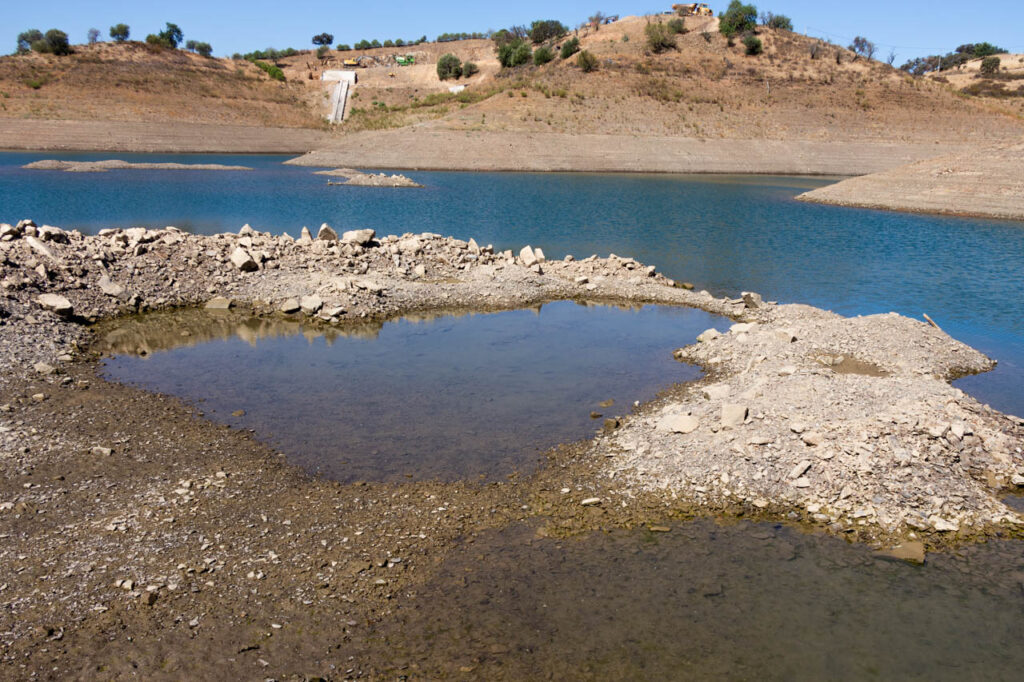Freeze drying is a process commonly applied to foods, which basically consists of freezing them and then subjecting them to a process that removes the water from them. In this way, a state of conservation that can last for decades is obtained.
Well, the Algarve is more or less like this, pushing for freeze-dried products. Only bad. The result of a succession of hydrological years that left the region in clear water deficit and stress, it is not preserved, but rather parched like a raisin.
From there, in order to hydrate us, the Government headed south, through the Minister of Environment and the Minister of Agriculture, bringing us the Regional Water Efficiency Plan of the Algarve (PREHA), which Moisés descending the slope of Mount Sinai with the Tables of the Law. And this ministerial duo, proved to have an almost prophetic and miraculous effectiveness, because immediately after its presentation… it rained!
Who knows, knows, and the rest is talk.
But, drips aside, the problem of water in the Algarve has even made the President of the Republic say that it is perhaps the most important in the region. Interestingly, he said it a few kilometers from the implantation of a few more good and fresh hectares of irrigated land at the foot of Cerro de S. Miguel…
The plan presented seems more reactive than proactive. In other words, it seems to design tools to better chase the damage, but not so much to avoid suffocation.
In the Algarve, more than just having little water, there are many justified doubts about its (re)supply. Because uncertainty in the amount and distribution of precipitation – which is what fuels us – is the standard in the Mediterranean climate context. Add to that the magnifying effect of the current climate change cycle, and the problem is really how to manage interrogations.
Those who arrive from outside and look at the Algarve do not guess such a thing, as they only see certainties, with the water that is not there, being managed as if it had avonde, with a transversal carelessness. Whether in an urban context or in agriculture, the use we make of it is clearly not designed for a limited resource.
And PREHA – in fairness, the elements made available in the PREHA presentation – does not seem to greatly question this attitude, throughout its promised 228 million euros of investment.
Every time our mouths dry a little, the same people there always tell us: this will only go there with one more dam. PREHA endorses this idea, admitting new dams on the Foupana and Alportel streams – in the latter, curiously, a tourist development is already being planned which, sorcerer, anticipates a marginal location to a water level.
It is true that the plan also proposes an approach to the aspects of efficiency, losses, inspection (who, with what resources?) and alternative sources of water. In this last chapter, he says that he will desalinate sea water, fish water from the Guadiana and reuse wastewater.
In the first experience, we were slow to move forward, the second is an endless sum of “ifs” (including an agreement with Spain for “water solidarity”, something we have had in abundance…) and in the third, lucky those who find them available, and daring those who assume the burden of ensuring the quality of the wastewater that the State delivers, in light of the labyrinthine Decree-Law No. 119/2019!
But and why does the bet on dams sound so inadequate? If no one denies their importance as reserves, then is it “only” because the dams are extremely heavy infrastructures, with high economic and environmental costs? Or is it because they are being thought out of their necessarily strategic nature?
This doubt is legitimate, especially in the Algarve, where just a decade after the completion of the last – and largest – regional dam, what was promised to be resolved was not resolved.
What went wrong anyway? Perhaps reality, with its impertinent habit of imposing itself.
But this sacrilegious question is for Portuguese “strategic” thinking like the cross for the Devil: it is to flee. That is why, with each new presentation of studies, plans and strategies, there is never an in-depth reflection on what has failed in previous studies, plans and strategies, which leads to mistakes being repeated. Without anyone being held accountable. And if there's any case worth thinking about, this is it.
PREHA recognizes, in capital letters, bold and bold letters, that the “problem of the SECA in the Algarve region is not circumstantial, it is STRUCTURAL”.
The first dams in the Algarve – Arade and Bravura – were built in the 1950s. In 1986, the Beliche dam was completed. In the 90s, in a short interval, the Funcho and Odeleite dams came into operation. Ten years ago, the filling of the reservoir of the Odelouca dam began, the one that has the particularity of being the largest in the region, and which, allegedly, would permanently solve the water problems in the Algarve.
In the same period, the average rainfall for the Algarve dropped from around 650 mm, in the period between the 40s and 70s of the 570th century, to 1986 mm, between 2018 and 1989 (even with an average inflated by exceptional years such as 1996 , 2010 and 1000, each with values in the region of XNUMX mm).
In other words, everything indicates that we are on a decreasing trend with regard to rain.
If it rains less and less, is that horse we bet on? Or would it be better to think of a camel?
Also at the same time, between the 1950s and, more or less, today, water consumption in the Algarve at least tenfold. This is explained by an increase of about 37% of the population in that period, by the increase in the coverage of the supply and sanitation systems in the region, by the increase in tourist pressure - mainly in the months with less rainfall - and by the strong increase in irrigation , mainly in agriculture, thanks to dams and also to deeper underground abstractions, using pumping.
This proves that the region, when it comes to water, as in other matters, is not much given to making piggy banks. Because with each new storage reinforcement, with each new slack, the region responds with more and more consumption.
So, whenever you increase your water reserves (particularly the superficial ones) it is not so much because you want to create some safety margin for the bottlenecks that you inescapably know will pass sometime in the future, but to be able to continue to leak water, pushing with the belly worries.
Basically, instead of adjusting its needs to availabilities, the Algarve has followed a path of looking for availabilities that cover the growing needs it is creating in a context of less and less rain, that is, it is betting on an environmental credit move it has everything to go wrong, and getting worse.
By the way, was the Intermunicipal Plan for Adaptation to Climate Change in the Algarve, which also deals with this topic, considered in the preparation of PREHA?
So it's not that having more reserves is bad. Making investments – which could be directed towards more effective measures – to have more reserves that are likely to always be in deficit, and which will serve a model of misuse and waste, is what is bad.
And that is why this Plan that now presents itself, despite the generosity of some of its proposals and the kindness of all the people who contributed to it, runs the risk of only splashing on the surface of the problem. Until the structure is attacked, the admittedly structural problems are not solved.
Changing the structure involves rethinking a lot of things in depth. Not only in direct human consumption, but also in the ecological perspective of water.
The fact that regional aquifers are, on average, at levels below 20%, causing not only scarcity, but qualitative degradation of water and risks of saline intrusion in some groundwater bodies, is a first-order problem, as salinization aquifers and soil is a vanguard of desertification (and we have very close examples).
Perhaps it was time, for example, to apply the user/payer principle to groundwater, at least for large-scale consumers. Perhaps this way, irrigation in an area of water scarcity/uncertainty is no longer so irresponsible, just to give an example in the sector responsible for most consumption.
Many more could be given, of course, in all consumer sectors.
But before that, and in order not to waste more Latin in vain, it is necessary to realize that the resolution of this problem will not come from a plan. Unfortunately, we've also already realized that it won't come from decision makers.
Only society, as a whole, will be able, if it so chooses, to take the trouble to think responsibly in depth about the issue, act accordingly and demand, also acting, that things change profoundly.
Or not. It's in our hands.
Until then, choose between the suggestions of an ex-minister or an optimistic deputy, and pray or wait for it to rain.
Author Gonçalo Gomes is a landscape architect, president of the Algarve Regional Section of the Portuguese Association of Landscape Architects (APAP).
(and writes according to the old Spelling Agreement)
Help us to do the Sul Informação!
Contribute your donation so that we can continue to make your journal!
Click here to support us (Paypal)
Or use our IBAN PT50 0018 0003 38929600020 44



















Comments